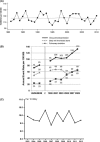Current and future burden of venous thrombosis: Not simply predictable
- PMID: 30046722
- PMCID: PMC6055567
- DOI: 10.1002/rth2.12101
Current and future burden of venous thrombosis: Not simply predictable
Abstract
Venous thrombosis is a major contributor to the global disease burden. In this review we aim to answer two important questions: (1) are we making progress in reducing this disease burden and (2) how can we further improve? To answer these questions, we first evaluated the disease burden, that is, the incidence of first venous thrombosis over the past decade(s) and discuss its most important determinants. We found that the incidence of first venous thrombosis remained relatively unchanged, despite an increase in risk factor prevalence and a rise in identification of subsegmental pulmonary emboli due to enhanced image quality and utilization. This is, however, balanced by improved thromboprophylaxis strategies, resulting in an overall unchanged venous thrombosis incidence. We can further improve by developing, validating, and implementing risk assessment strategies, allowing us to identify persons at high or low risk in whom thromboprophylaxis can be provided or withheld, respectively.
Keywords: epidemiology; incidence; risk assessment; risk factors; venous thrombosis.
Figures



References
-
- Tagalakis V, Patenaude V, Kahn SR, Suissa S. Incidence of and mortality from venous thromboembolism in a real‐world population: the Q‐VTE Study Cohort. Am J Med. 2013;126:832.e13–e21. - PubMed
-
- Naess IA, Christiansen SC, Romundstad P, Cannegieter SC, Rosendaal FR, Hammerstrom J. Incidence and mortality of venous thrombosis: a population‐based study. J Thromb Haemost. 2007;5:692–9. - PubMed
-
- Delluc A, Tromeur C, Le Ven F, et al. Current incidence of venous thromboembolism and comparison with 1998: a community‐based study in Western France. Thromb Haemost. 2016;116:967–74. - PubMed
-
- van Es N, Coppens M, Schulman S, Middeldorp S, Buller HR. Direct oral anticoagulants compared with vitamin K antagonists for acute venous thromboembolism: evidence from phase 3 trials. Blood. 2014;124:1968–75. - PubMed
LinkOut - more resources
Full Text Sources
Other Literature Sources
Miscellaneous

